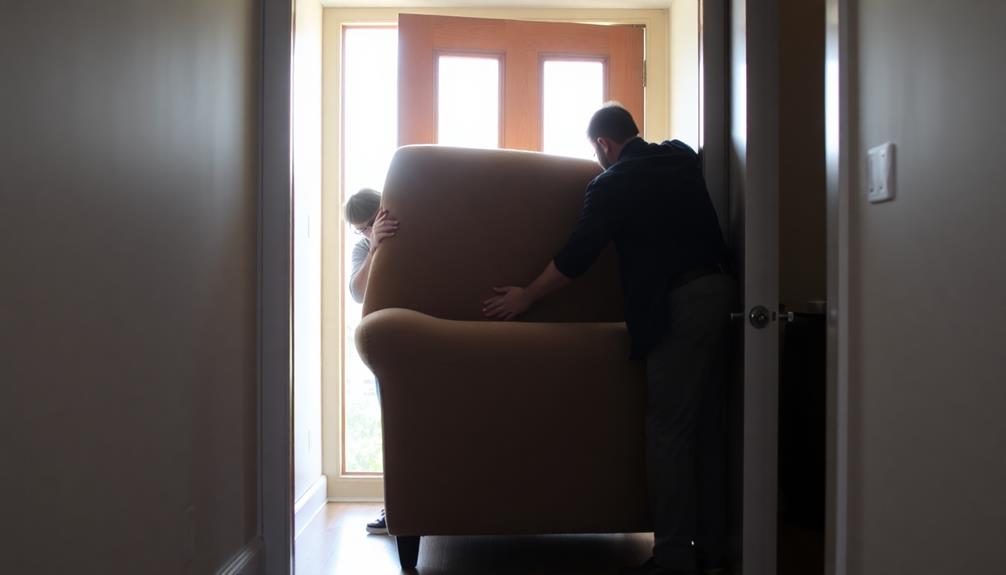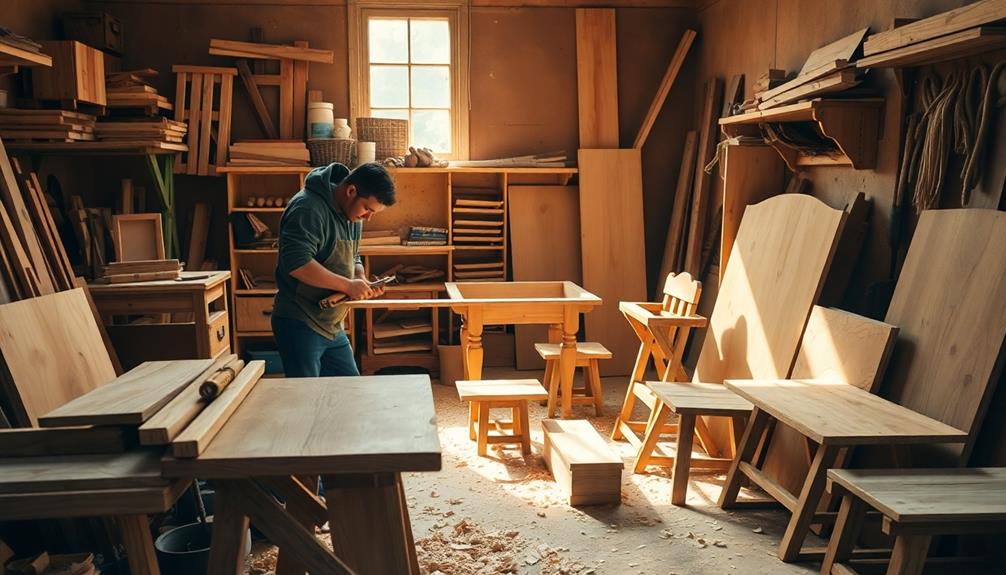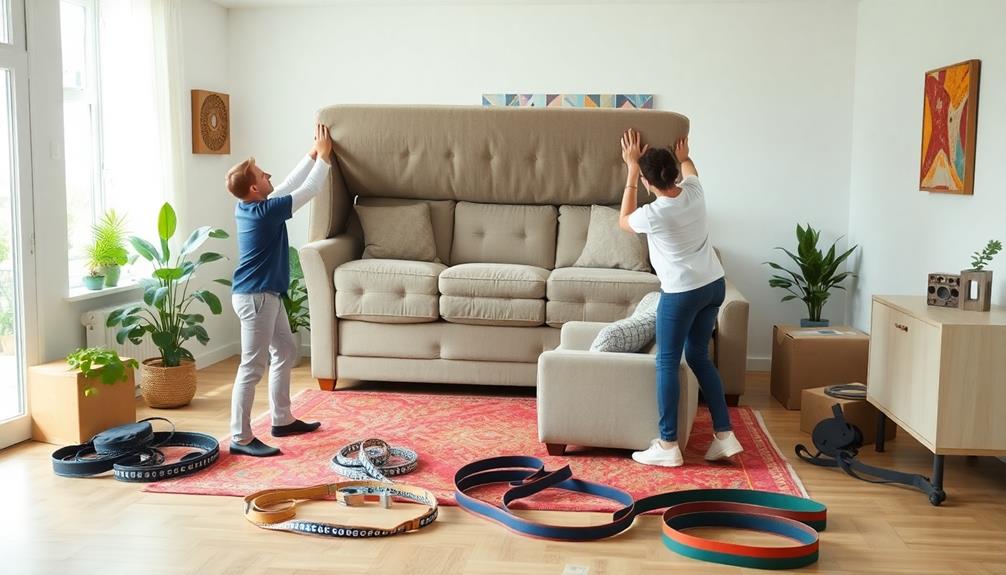To successfully navigate your sofa through a door, the first step is to measure both the sofa and the doorway dimensions. Take off any removable parts such as legs and cushions to make it easier to move. employ the pivot technique by angling the sofa at 45 degrees for a better fit. If it’s too snug, consider taking the door off its hinges for more room. Remove any obstacles in the way to avoid accidents. Remember to lift correctly by bending your knees. For additional tips and detailed methods to streamline the process, be sure to review the following steps for a smoother move.
Key Takeaways
- Measure the sofa and door dimensions to ensure fit, considering width and height at the widest and tallest points.
- Remove detachable components like cushions and legs to simplify maneuverability.
- Utilize the pivot method or tilt the sofa at a 45-degree angle for easier navigation through the doorway.
- If necessary, remove the door from its hinges to increase clearance and facilitate movement.
- Clear the path of obstacles, ensuring a well-lit area for safe and efficient moving.
Preparation and Planning
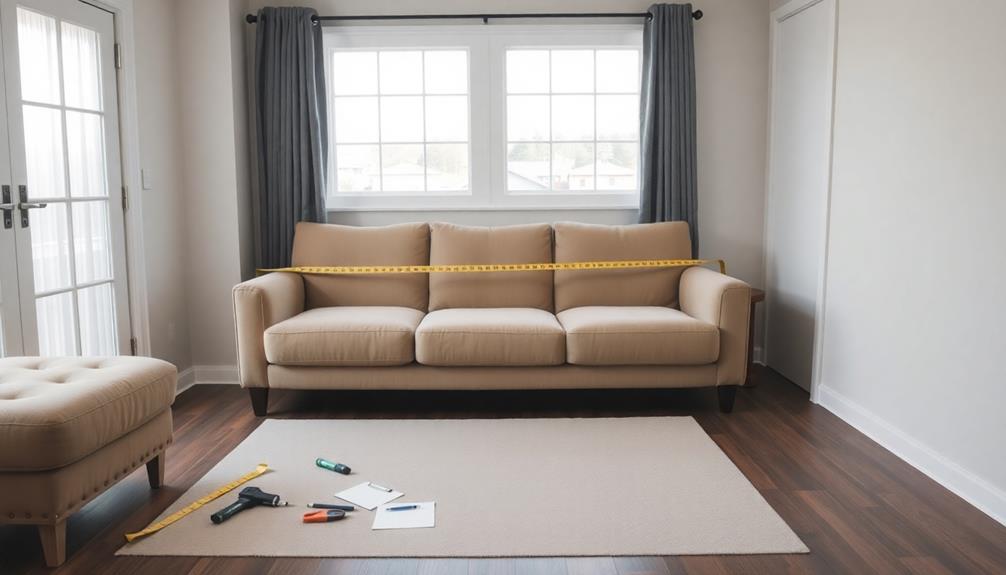
When you're getting ready to move a sofa, careful preparation and planning are vital for a successful outcome. Start by measuring the couch dimensions, including its height, width, and depth. This guarantees it can fit through the door before you attempt to move it.
Additionally, consider how common reasons for heat pump failure can apply to furniture moving; just like inadequate maintenance can lead to issues with heat pumps, lack of planning can lead to complications during your move.
Next, assess the doorway measurements, noting both the width and height. Look for any obstacles or obstructions that could hinder your movement.
Removing any detachable components from the couch, like cushions and legs, will greatly reduce its bulk. This makes it easier to maneuver through the door and around corners.
Planning your moving route in advance is essential; consider wider openings and alternative paths to avoid narrow spaces that could complicate the process.
Utilize geometry to determine the best angles for guiding the couch. Think about how to tilt or turn it to fit through the doorway without causing injury or damage.
Measuring Couch and Doorway
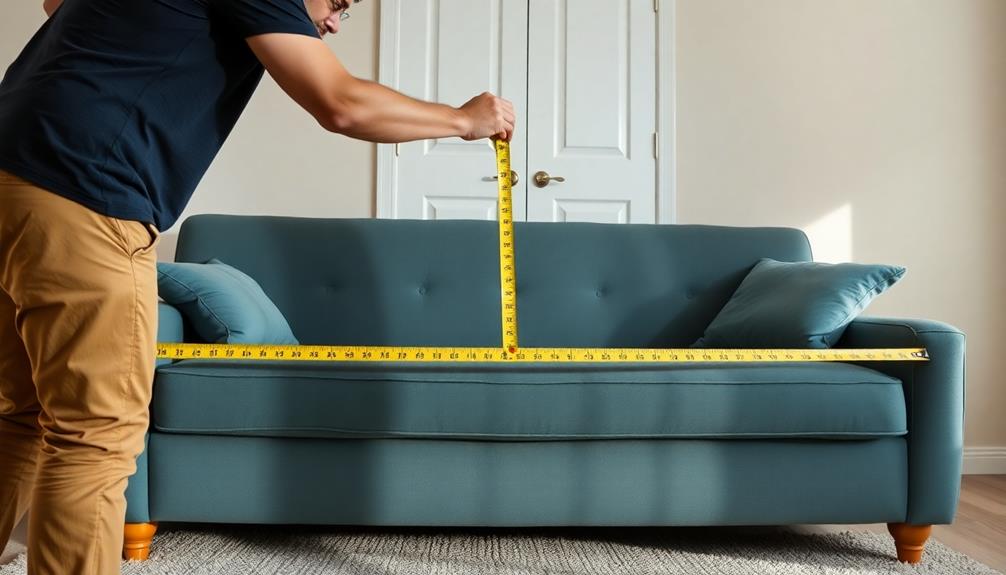
Before you move your couch, you need to measure its dimensions—height, width, and depth—to see how it'll fit through the doorway.
Standard doorways are usually 80 inches tall and 36 inches wide, so make certain your couch can navigate these spaces.
It's also vital to take into account the layout of the room and any obstacles that might make maneuvering difficult.
Additionally, if you're using an air purifier in the area, verify that it's properly maintained for peak performance, as air purifier maintenance can help reduce allergens while you move.
Also, don't forget to check for any removable parts that could make the process smoother.
Accurate Couch Dimensions
Measuring your couch accurately is essential for ensuring it fits through doorways without a hitch. Start by measuring the couch's height, width, and depth, focusing on the widest and tallest points. This will give you the accurate couch dimensions needed to navigate narrow doorways.
Remember, standard doorways typically measure 80 inches in height and 36 inches in width, so your couch should be less than these measurements for a successful fit. Additionally, using an airless paint sprayer can help refresh the look of your couch or surrounding area with a new coat of paint, providing a smooth finish and saving you time on your project efficient paint application.
If your couch is less than 80 inches wide, you might be able to maneuver it vertically through standard doors. For those with a height or depth of 29 inches or less, moving it horizontally could be an option.
To make the process smoother, consider removing any detachable components like removable feet or cushions. This can greatly reduce the overall size of your couch.
Lastly, use a measuring tape to assess all doorways and openings along your moving path. Be sure to note any obstructions or limitations that may affect your ability to move the sofa through the door frame effectively.
Assessing Doorway Measurements
To guarantee your couch makes it through the doorway, evaluating the doorway measurements is essential. First, measure your couch's height, width, and depth at the widest and tallest points.
Remember, standard interior doorways are typically 80 inches high and 30-36 inches wide, so verify your couch dimensions don't exceed these measurements. Additionally, consider how certain environments, like a cluttered living room, might require the use of essential oils for relaxation to ease any stress during the moving process.
For best maneuverability, couches less than 80 inches wide can usually be moved vertically through standard doorways. If your couch is over 29 inches high or deep, you'll need to move it horizontally.
It's also a good idea to measure the door opening with the door swung open; the thickness of the door can reduce the effective width by about 1.25 inches.
Don't forget to check for potential obstructions around the doorway, like hinges or doorstops. If you spot any, consider removing them to create additional space.
This will help verify your couch can fit through easily without any hassle. By taking the time to measure and assess, you'll make moving your couch a smoother and more successful experience.
Techniques for Maneuvering
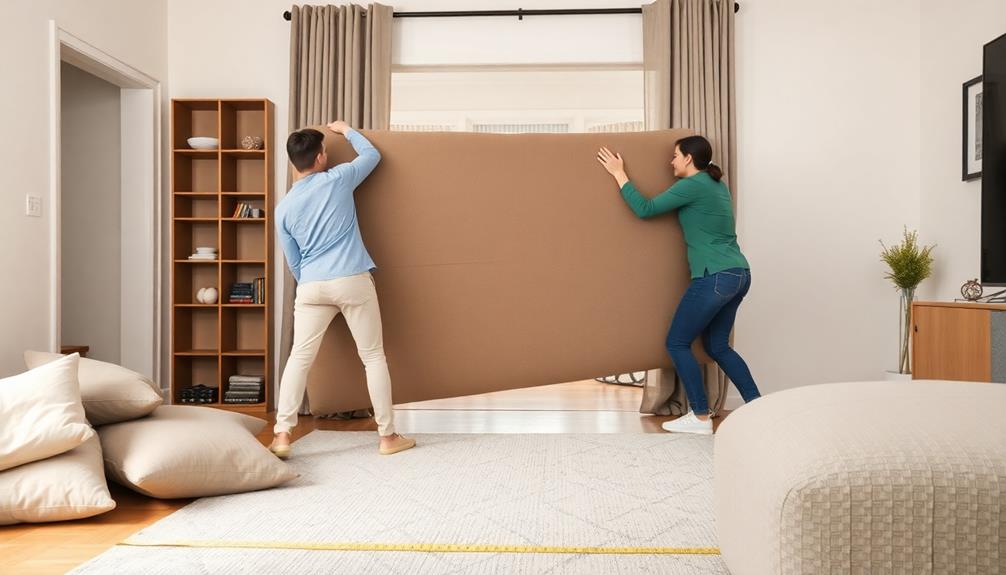
Maneuvering a sofa through a doorway requires a strategic approach to avoid frustration and potential damage. Start by disassembling the couch; remove any detachable components like cushions and legs. This reduces the overall dimensions, making it easier to navigate through narrow spaces.
Additionally, it can be helpful to apply the same level of care and attention that's given to brewing methods, ensuring that each step of the maneuver is executed thoughtfully.
Next, employ the pivot method: tilt the couch at a 45-degree angle. This technique helps angle the width of the sofa to fit through standard doorways more effectively. For larger sofas, consider moving your couch vertically by standing it on end. This can provide a more manageable width for passage when supported properly.
If the doorway is still too tight, you might want to remove the door from its hinges. Doing so can give you an extra 1.25 inches of clearance, facilitating a smoother move.
Throughout the process, it's crucial to communicate clearly with your partner. Coordinate your movements, ensuring both ends of the couch are lifted and maneuvered simultaneously. This teamwork will help prevent jamming or damaging the doorframe, making your sofa-moving experience much more successful.
Door Removal Strategies
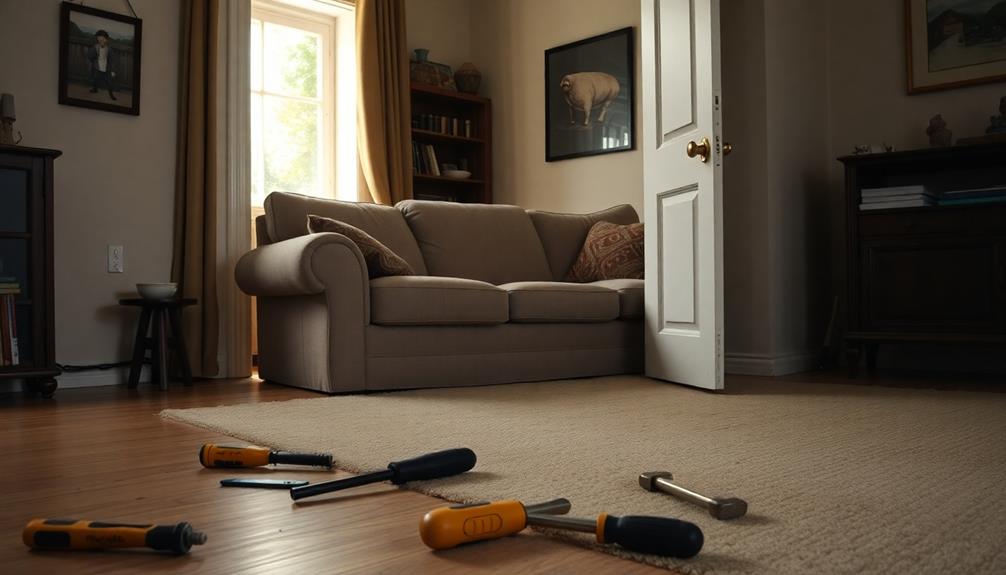
Sometimes, even with clever maneuvering techniques, a sofa just won't fit through a doorway. In such cases, removing the door can be a game-changer, providing an extra 1.25 inches of width that might make all the difference.
Understanding the concept of budgeting for home projects can help you plan for any potential costs associated with moving furniture.
Here's how to effectively remove interior doors for better clearance:
- Tap out the hinge pins: Use a flathead screwdriver to quickly and simply detach the door without unscrewing hinges.
- Consider doorstops: Removing doorstops can further increase the opening size, making maneuvering easier.
- Measure the space: If removing the door isn't feasible, make sure to measure from the doorstop to the door edge to assess the available clearance.
- Rehang with ease: Once the sofa is through, rehanging the doors is straightforward, helping you maintain the room's aesthetic.
Safety Tips During Moving
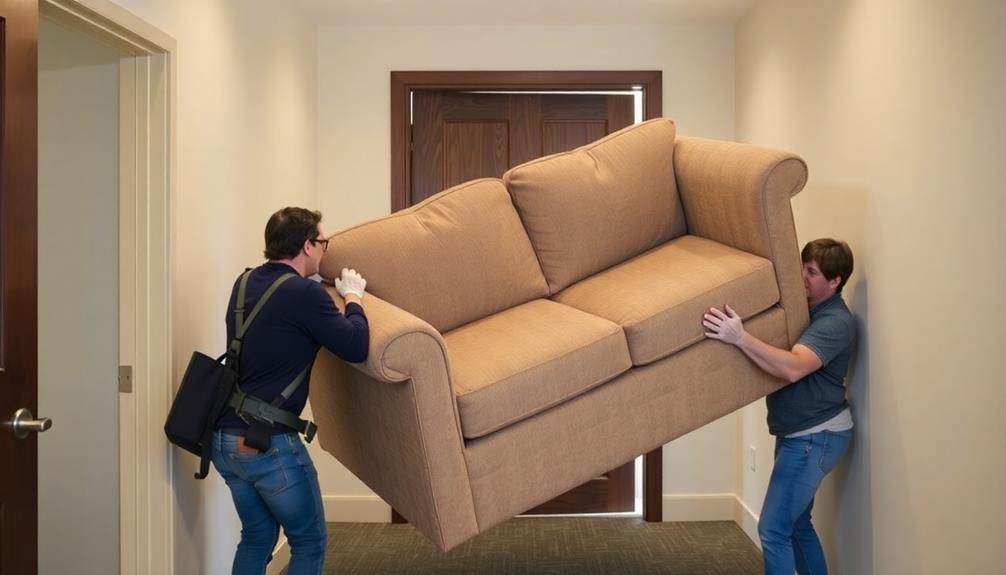
How can you guarantee a safe and efficient move when maneuvering bulky furniture like a sofa? First, always wear gloves to improve your grip and prevent cuts or bruises from sharp edges.
Additionally, consider financial considerations for elderly care when planning a move, as it can involve unexpected costs.
Next, clear the moving path of any obstacles, like furniture or debris, to minimize the risk of tripping and injury during the move.
It's essential to communicate clearly with your moving partner throughout the process. Use simple instructions to coordinate movements and avoid accidents.
Additionally, make sure the area is well-lit, so you can easily spot potential hazards like uneven flooring or low-hanging fixtures.
When you're ready to lift, remember to use proper lifting techniques. Bend at your knees and keep your back straight to reduce the risk of strain or injury.
This not only helps you but also protects the sofa from damage during the move.
Post-Move Setup
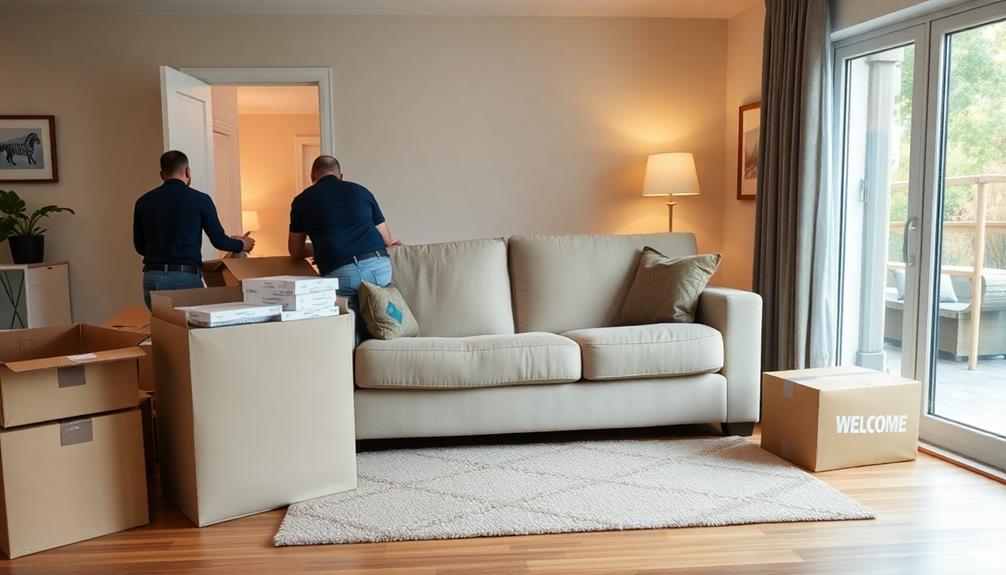
Once you've got your sofa in place, take a moment to inspect it for any damage.
This is also a good time to contemplate enhancing your home security, as studies show homes without security systems are 300% more likely to be burglarized increased safety and peace of mind.
If any parts were removed during the move, reattach them to guarantee your sofa looks and functions its best.
Inspect for Damage
After moving your sofa into its new space, it's important to inspect it for any damage that may have occurred during transport. Tight spaces, like doorways, can lead to scratches, dents, or tears on your couch. A thorough examination will help guarantee your sofa looks great and functions well.
Additionally, you might want to take into account using home remedies for cleaning any stains that may have developed during the move.
Here are some key areas to check:
- All sides: Look for visible scratches or dents.
- Seams and upholstery: Check for loose threads or fabric snags.
- Removable parts: Verify legs and cushions are securely reattached.
- Photograph damage: Document any issues for future reference.
If you spot any damage, it's a good idea to take photographs for documentation. Think about reaching out to a professional upholstery repair service for an assessment and potential repairs.
Finally, clean your sofa with appropriate fabric cleaners to remove any dust or debris that may have accumulated during the move. This way, you'll not only keep your couch in top shape but also make sure it looks its best in its new location.
Taking these steps will help maintain the integrity and appearance of your sofa for years to come.
Reattach Removed Parts
Reattaching any removed parts of your sofa is essential for guaranteeing its stability and comfort. Once you've moved it into the desired location, start by reattaching the legs and any cushions that were taken off. This step is vital to prevent wobbling and guarantee a sturdy seating experience.
Additionally, just like with appliances, proper maintenance of your furniture can greatly extend its lifespan. Regularly inspecting and tightening screws, much like the importance of preventive maintenance for appliances, can help avoid any issues down the line.
Make sure to check that all screws and fasteners for the detachable components are properly aligned and tightened. Refer to any notes or documentation you made during disassembly; this will help you reassemble everything in the correct order. If you encounter any damage during your post-move inspection, like scratches or dents, address those issues before fully reassembling your sofa.
Once you've reattached all the parts, take a moment to double-check that everything is secure. This won't only enhance the stability of your sofa but also prolong its lifespan.
Arrange Surrounding Furniture
Arranging the surrounding furniture is essential for creating a harmonious living space after moving your sofa.
Start by evaluating the room layout to determine the best arrangement for ideal flow and accessibility around the new placement. Consider the dimensions of your surrounding furniture to guarantee everything complements each other without overcrowding or blocking pathways.
Here are some tips to guide you:
- Clear pathways: Make sure there's enough space around the sofa for easy movement, especially near door openings.
- Enhance natural light: Position your couch to take advantage of natural light sources and highlight focal points in the room.
- Use visual aids: Experiment with floor plans or furniture arrangement apps to visualize different setups before finalizing the position.
- Mind the traffic: Keep high-traffic areas free of obstacles to prevent tripping hazards and promote a comfortable flow.
Additional Resources and Options
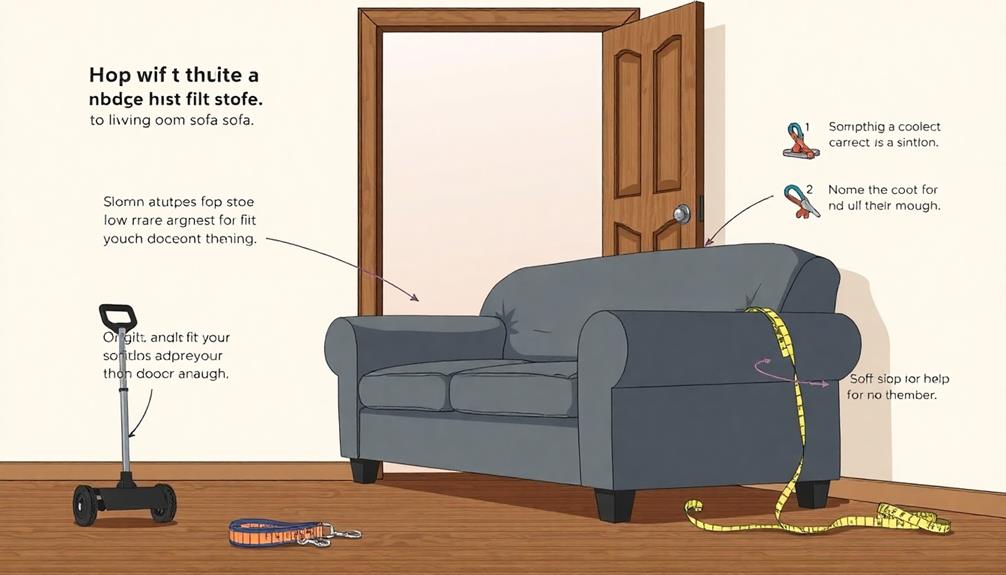
Maneuvering the challenge of getting a sofa through a doorway can be intimidating, but you don't have to tackle it alone. Consider utilizing professional moving services that specialize in furniture transport. They can make it easier by safely handling your sofa, especially through tight spaces.
If you prefer a DIY approach, start by researching tips and tricks shared by others who've successfully moved large furniture. Online forums can be a goldmine for advice.
You might also want to check out instructional videos that demonstrate effective techniques for getting couches through doors. Watching these can give you a clearer idea of the process, including the option of removing the hinges to create extra space.
Before you proceed, read customer reviews for removal services to guarantee reliability and quality if you choose to hire help. Signing up for newsletters from furniture retailers or moving companies can also provide insights and promotions related to furniture fitting.
With these resources at your disposal, you'll feel more confident and prepared to tackle the task ahead. Remember, whether you go it alone or enlist help, there are plenty of options to make this process smoother.
Frequently Asked Questions
What Do You Do if Your Couch Doesn't Fit Through the Door?
If your couch doesn't fit, start by measuring both it and the doorway. You can remove detachable parts, try angling it, or even disassemble it into smaller sections for easier transport.
How Do You Get an Oversized Couch Through a Door?
Imagine wrestling your oversized couch like a stubborn beast. You've measured, removed cushions, and now you're pivoting it on its end. Don't forget to clear the path and maybe even take off the door!
How Do I Make Sure My Sofa Fits Through the Door?
To guarantee your sofa fits through the door, measure its dimensions against the door's. Remove any detachable parts, check the door's swing, and try angling the sofa diagonally for a smoother passage.
What Happens if New Sofa Doesn't Fit Through Door?
When your new sofa feels like a giant puzzle piece, you find yourself at a crossroads. If it doesn't fit, explore options like removing parts or considering alternative entry points for a smoother changeover.
Conclusion
Getting your sofa through the door might feel like a Herculean task, but with careful planning and the right techniques, you can make it happen. Measure everything twice, use clever maneuvering, and don't hesitate to remove the door if needed. Remember, safety first! Once you've successfully navigated this challenge, you'll be ready to set up your space just the way you like it. In the end, it's all about finding the right angle to make it fit. If you’re still having trouble, consider enlisting a friend or professional mover to help you out. For those tackling home projects like this, whether it’s furniture or larger tasks such as **garage door installation in Tucson**, having an extra set of hands can make all the difference. With a little patience and persistence, you’ll have your home in order in no time. As with any home project, a bit of research beforehand can go a long way in ensuring success. Whether it’s squeezing your sofa into place or learning some Tucson garage door installation tips, preparation is key. By staying calm, taking your time, and asking for help if necessary, you’ll be better equipped to tackle any household challenge that comes your way.
